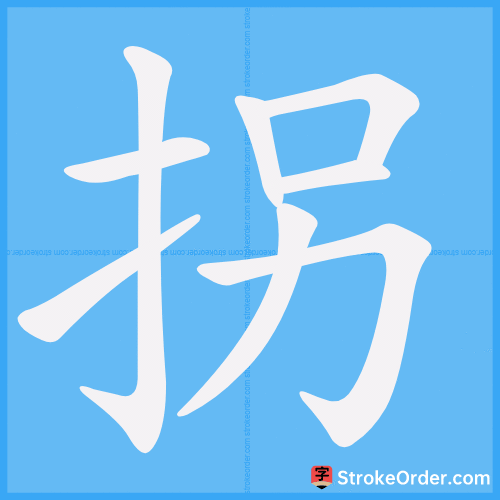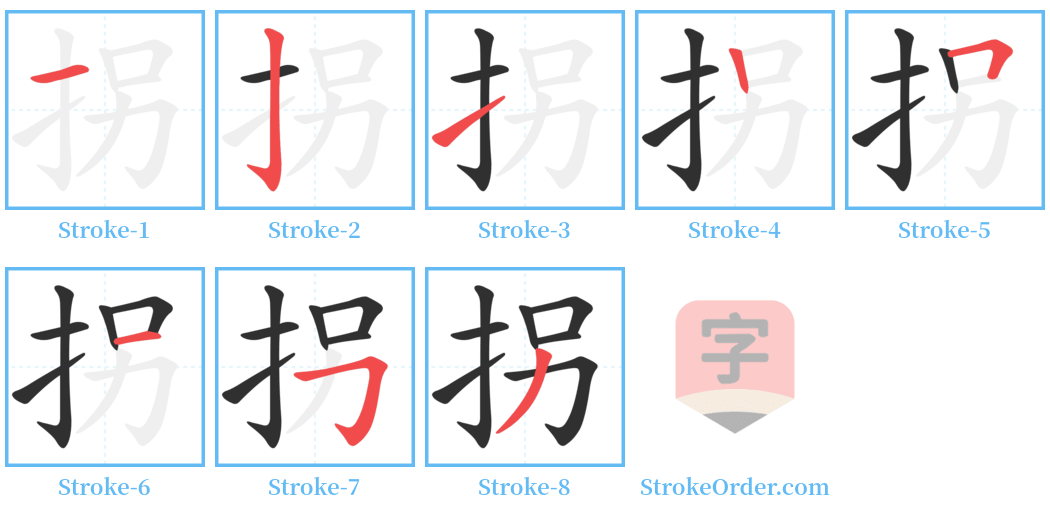拐 Stroke Order
Animated Stroke Order of 拐

Stroke Order Diagrams for 拐

Step-by-Step Handwriting Guide for 拐

Learn to Write Chinese Characters with Video Tutorials
Watch the video of writing the Chinese character "拐", learn the correct stroke order (笔顺) of the character "拐", and master the standard way of writing the character "拐".
Free Printable Handwriting Practice with Stroke Order: 拐
Printable Writing Practice Worksheet of "拐" in Portrait Orientation (Tian Zi Ge)

Printable Writing Practice Worksheet of "拐" in Landscape Orientation (Tian Zi Ge)

Information of 拐
Pinyin
guǎi
Radical
扌
Strokes
8 strokes
Usage
★★★★★
Definition
kidnap / to turn
拐 [guǎi]
1. 转折: A turning point; a bend.
2. 骗: To deceive; to trick.
3. 走路不稳,跛: To walk unsteadily; to limp.
4. 走路时帮助支持身体的棍: A stick used for support while walking; a crutch.
1. 转折: (e.g., 〜弯) a bend, turning.
2. 骗: (e.g., 〜骗, 〜卖) abduct; deceive; cheat (by selling).
3. 走路不稳,跛: He walks unsteadily.
4. 走路时帮助支持身体的棍: (e.g., 〜棍, 双〜) crutch; double crutch.
Definition: A crutch.
Origin: Shape-sound character; derived from hand.
Verb:
1. 诱骗: To abduct; to deceive women or children to take them away.
(e.g., 《红楼梦》: She bought a maid one day, not knowing she had been abducted.)
2. 转弯: To turn, often refers to changing direction while moving.
(e.g., Walk one hundred meters forward, then turn right to reach his house.)
3. 用臂肘碰: To elbow.
(e.g., Use your elbow to nudge him.)
4. The corner or curve (dialect): A bend, a corner.
(e.g., door corner; wall corner.)
Adjective:
1. 错的,坏的: Wrong (e.g., Don’t twist the words around; to speak misleadingly).
2. 跛行的,瘸的: Lame.
(e.g., A person who limps or has a disability; his walk is unsteady.)
lit. going round the curves and skirting the corners (idiom) / fig. to speak in a roundabout way / to equivocate / to beat about the bush
turning point / breaking point / inflexion point (math., a point of a curve at which the curvature changes sign)
Input Method for 拐
Pinyin
guai3
Wubi
rkln|rket
Cangjie
qrks
Zhengma
djym
Four Corner
56027
Unicode
U+62d0